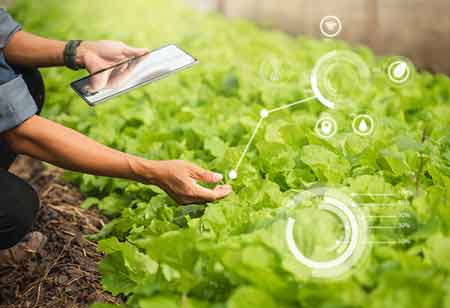Thank you for Subscribing to Agri Business Review Weekly Brief
The Digital Infrastructure Transforming LATAM Agri-business
Latin America is transforming its agriculture through advanced management solutions, emphasizing data-driven, precision farming, enhanced connectivity, and AI to boost efficiency and sustainability.

By
Agri Business Review | Monday, July 28, 2025
Stay ahead of the industry with exclusive feature stories on the top companies, expert insights and the latest news delivered straight to your inbox. Subscribe today.
Latin America is a pivotal region in global agriculture, recognized for its vast arable lands and significant contributions to worldwide food production. The agricultural sector across the continent is currently undergoing a profound transformation, driven by the increasing adoption of advanced management solutions. This shift is not merely an incremental improvement but a fundamental reorientation towards data-driven, efficient, and sustainable farming practices.
Digital Foundation: Software and Precision Agriculture
At the heart of this evolution are farm management software platforms, which serve as central hubs for aggregating and analyzing diverse agricultural data. These platforms offer comprehensive functionalities, ranging from detailed field mapping and crop monitoring to inventory management and labor allocation. By providing a holistic view of farm operations, they empower agricultural producers to make informed decisions, moving away from conventional, generalized approaches to highly tailored and precise interventions. The demand for these software solutions is escalating, reflecting a broader recognition of their potential to streamline processes and unlock new levels of efficiency.
A key pillar of agricultural management solutions in Latin America is precision agriculture. This paradigm leverages sophisticated technologies to apply inputs such as water, fertilizers, and pesticides with unprecedented accuracy, matching the specific needs of distinct areas within a field. The adoption of precision agriculture tools, such as GPS-guided machinery and variable rate technology, is steadily expanding across the region. Countries with large-scale agricultural operations have been early adopters, utilizing these technologies to optimize yields and minimize waste across vast tracts of land. This site-specific management approach is fundamentally changing how resources are managed, resulting in more sustainable practices and a reduced environmental impact.
Data at the Core: Connectivity, IoT, and Analytics
The proliferation of digital agriculture is closely tied to advancements in connectivity and data infrastructure throughout Latin America. While regional variations exist, there is a clear upward trend in the availability of broadband and satellite internet solutions, which is extending their reach to more remote farming areas. This enhanced connectivity is crucial for the effective deployment of smart farming solutions, enabling the transmission of real-time data from sensors, drones, and other connected devices. The ability to collect and transmit vast amounts of data seamlessly is a prerequisite for leveraging the full potential of modern agricultural management systems.
Internet of Things (IoT) devices and sensor technologies are playing an increasingly vital role in capturing granular data from the field. Soil moisture sensors, weather stations, and crop health monitors provide continuous streams of information, allowing producers to track critical parameters with precision. This real-time monitoring facilitates immediate adjustments to irrigation schedules, nutrient applications, and pest management strategies. The integration of these sensors into broader management platforms provides actionable insights, resulting in more efficient resource utilization and enhanced crop performance.
The vast datasets generated by these interconnected systems are fueling the growth of agricultural big data analytics. The sheer volume and variety of agrarian data – from historical yield records and weather patterns to satellite imagery and sensor readings – require advanced analytical capabilities. By applying sophisticated algorithms and machine learning techniques, these platforms can uncover hidden patterns, predict outcomes, and provide predictive insights for better decision-making. This analytical prowess enables proactive management, allowing producers to anticipate risks and optimize operations before issues arise.
Intelligent Agriculture: AI and Remote Sensing
AI-powered systems analyze complex data sets to offer intelligent recommendations, automate tasks, and enhance decision-making across various farming activities. From optimizing planting and harvesting schedules to predicting disease outbreaks and providing personalized crop management advice, AI is elevating the precision and effectiveness of agricultural practices. Its application extends to livestock monitoring and environmental management, showcasing its versatility in addressing diverse agrarian needs.
Satellite imaging and remote sensing are fundamental components of modern agricultural management in the region. High-resolution, multi-spectral imagery provides valuable insights into crop health, growth stages, and potential issues across large areas. These visual data streams, often integrated into farm management platforms, enable widespread monitoring and facilitate targeted interventions. The ability to observe and analyze agricultural landscapes from above provides a powerful tool for strategic planning, resource allocation, and identifying areas that require immediate attention.
A strong momentum towards digitalization and technological integration characterizes the state of agricultural management solutions in Latin America. The overarching trend is one of continuous innovation, driven by the imperative to increase productivity, enhance sustainability, and optimize resource use. As the region continues to embrace these advanced solutions, the agricultural sector is poised for further growth, establishing itself as a global leader in efficient and technologically advanced food production. The journey is ongoing, with a clear trajectory towards more intelligent, interconnected, and resilient farming systems that will shape the future of agriculture across the continent.





